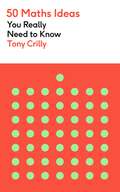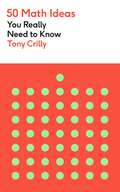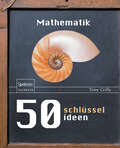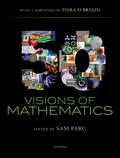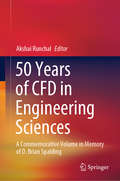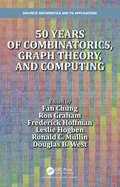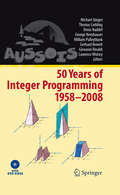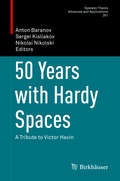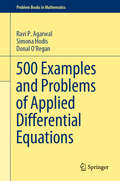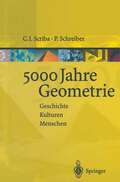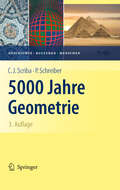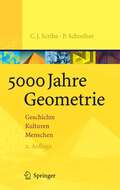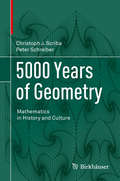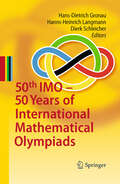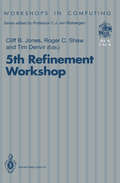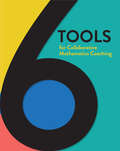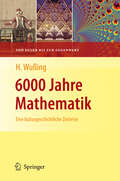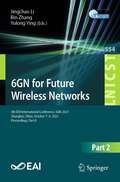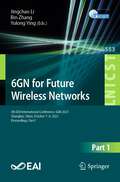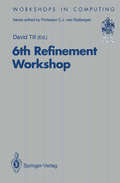- Table View
- List View
50 Maths Ideas You Really Need to Know (50 Ideas You Really Need to Know series)
by Tony CrillyIn a series of 50 accessible essays, Tony Crilly explains and introduces the mathematical laws and principles -ancient and modern, theoretical and practical, everyday and esoteric - that allow us to understand the world around us.From Pascal's triangle to money management, ideas of relativity to the very real uses of imaginary numbers, 50 Maths Ideas is a complete introduction to the most important mathematical concepts in history.
50 Maths Ideas You Really Need to Know (50 Ideas You Really Need to Know series)
by Tony CrillyIn a series of 50 accessible essays, Tony Crilly explains and introduces the mathematical laws and principles-ancient and modern, theoretical and practical, everyday and esoteric-that allow us to understand the world around us.From Pascal's triangle to money management, ideas of relativity to the very real uses of imaginary numbers, 50 Math Ideas is a complete introduction to the most important mathematical concepts in history.
50 Schlüsselideen Mathematik
by Tony CrillyDieser verständlich geschriebene Führer zur Gedankenwelt der Mathematik erklärt in kompakten und klaren Essays 50 zentrale Konzepte der Disziplin. Mit anschaulichen Grafiken, zahlreichen Beispiele und unterhaltsamen Anekdoten eröffnet das Buch auch denjenigen den Zugang, die ansonsten schon bei der bloßen Erwähnung des Wortes Mathematik in Panik geraten. Zu den näher erläuterten Schlüsselideen zählen imaginäre Zahlen, goldene Rechtecke und magische Quadrate ebenso wie die Gesetze der Genetik und das Geburtstagsproblem. Indem das Werk die Wissenschaft hinter den 50 entscheidenden Einsichten erkundet – vom Einfachen (wie der Zahl 1) über das Subtile (die Erfindung der Null) bis zum Komplexen (dem Beweis des Fermat’schen Theorems) –, verdeutlicht es auch, wie die Mathematik unsere Sicht auf die Welt verändert hat. Ohne die Erkenntnisse dieser Disziplin wären wir jedenfalls nicht dort, wo wir heute stehen. Mit diesem Buch können Sie mitreden.
50 Visions of Mathematics
by Dara O' BriainRelax: no one understands technical mathematics without lengthy training but we all have an intuitive grasp of the ideas behind the symbols. To celebrate the 50th anniversary of the founding of the Institute of Mathematics and its Applications (IMA), this book is designed to showcase the beauty of mathematics - including images inspired by mathematical problems - together with its unreasonable effectiveness and applicability, without frying your brain. The book is a collection of 50 original essays contributed by a wide variety of authors. It contains articles by some of the best expositors of the subject (du Sautoy, Singh and Stewart for example) together with entertaining biographical pieces and articles of relevance to our everyday lives (such as Spiegelhalter on risk and Elwes on medical imaging). The topics covered are deliberately diverse and involve concepts from simple numerology to the very cutting edge of mathematics research. Each article is designed to be read in one sitting and to be accessible to a general audience. There is also other content. There are 50 pictorial 'visions of mathematics' which were supplied in response to an open call for contributions from IMA members, Plus readers and the worldwide mathematics community. You'll also find a series of "proofs " of Phythagoras's Theorem - mathematical, literary and comedy - after this, you'll never think of Pythagoras the same way again.
50 Years of CFD in Engineering Sciences: A Commemorative Volume in Memory of D. Brian Spalding
by Akshai RunchalProf. D. Brian Spalding, working with a small group of students and colleagues at Imperial College, London in the mid-to late-1960’s, single-handedly pioneered the use of Computational Fluid Dynamics (CFD) for engineering practice.This book brings together advances in computational fluid dynamics in a collection of chapters authored by leading researchers, many of them students or associates of Prof. Spalding. The book intends to capture the key developments in specific fields of activity that have been transformed by application of CFD in the last 50 years. The focus is on review of the impact of CFD on these selected fields and of the novel applications that CFD has made possible. Some of the chapters trace the history of developments in a specific field and the role played by Spalding and his contributions. The volume also includes a biographical summary of Brian Spalding as a person and as a scientist, as well as tributes to Brian Spalding by those whose life was impacted by his innovations. This volume would be of special interest to researchers, practicing engineers, and graduate students in various fields, including aerospace, energy, power and propulsion, transportation, combustion, management of the environment, health and pharmaceutical sciences.
50 years of Combinatorics, Graph Theory, and Computing (Discrete Mathematics and Its Applications)
by Fan Chung, Ron Graham, Frederick Hoffman, Leslie Hogben, Ronald C. Mullin and Douglas B. West50 Years of Combinatorics, Graph Theory, and Computing advances research in discrete mathematics by providing current research surveys, each written by experts in their subjects. The book also celebrates outstanding mathematics from 50 years at the Southeastern International Conference on Combinatorics, Graph Theory & Computing (SEICCGTC). The conference is noted for the dissemination and stimulation of research, while fostering collaborations among mathematical scientists at all stages of their careers. The authors of the chapters highlight open questions. The sections of the book include: Combinatorics; Graph Theory; Combinatorial Matrix Theory; Designs, Geometry, Packing and Covering. Readers will discover the breadth and depth of the presentations at the SEICCGTC, as well as current research in combinatorics, graph theory and computer science.Features: Commemorates 50 years of the Southeastern International Conference on Combinatorics, Graph Theory & Computing with research surveys Surveys highlight open questions to inspire further research Chapters are written by experts in their fields Extensive bibliographies are provided at the end of each chapter
50 years of Combinatorics, Graph Theory, and Computing (Discrete Mathematics and Its Applications)
by Ronald C. Mullin Leslie Hogben Douglas B. West Fan Chung Ron Graham Frederick Hoffman50 Years of Combinatorics, Graph Theory, and Computing advances research in discrete mathematics by providing current research surveys, each written by experts in their subjects. The book also celebrates outstanding mathematics from 50 years at the Southeastern International Conference on Combinatorics, Graph Theory & Computing (SEICCGTC). The conference is noted for the dissemination and stimulation of research, while fostering collaborations among mathematical scientists at all stages of their careers. The authors of the chapters highlight open questions. The sections of the book include: Combinatorics; Graph Theory; Combinatorial Matrix Theory; Designs, Geometry, Packing and Covering. Readers will discover the breadth and depth of the presentations at the SEICCGTC, as well as current research in combinatorics, graph theory and computer science.Features: Commemorates 50 years of the Southeastern International Conference on Combinatorics, Graph Theory & Computing with research surveys Surveys highlight open questions to inspire further research Chapters are written by experts in their fields Extensive bibliographies are provided at the end of each chapter
50 Years of Integer Programming 1958-2008: From the Early Years to the State-of-the-Art
by Michael Jünger Thomas M. Liebling Denis Naddef George L. Nemhauser William R. Pulleyblank Gerhard Reinelt Giovanni Rinaldi Laurence A. WolseyIn 1958, Ralph E. Gomory transformed the field of integer programming when he published a paper that described a cutting-plane algorithm for pure integer programs and announced that the method could be refined to give a finite algorithm for integer programming. In 2008, to commemorate the anniversary of this seminal paper, a special workshop celebrating fifty years of integer programming was held in Aussois, France, as part of the 12th Combinatorial Optimization Workshop.It contains reprints of key historical articles and written versions of survey lectures on six of the hottest topics in the field by distinguished members of the integer programming community. Useful for anyone in mathematics, computer science and operations research, this book exposes mathematical optimization, specifically integer programming and combinatorial optimization, to a broad audience.
50 Years with Hardy Spaces: A Tribute to Victor Havin (Operator Theory: Advances and Applications #261)
by Anton Baranov Sergei Kisliakov Nikolai NikolskiWritten in honor of Victor Havin (1933–2015), this volume presents a collection of surveys and original papers on harmonic and complex analysis, function spaces and related topics, authored by internationally recognized experts in the fields. It also features an illustrated scientific biography of Victor Havin, one of the leading analysts of the second half of the 20th century and founder of the Saint Petersburg Analysis Seminar. A complete list of his publications, as well as his public speech "Mathematics as a source of certainty and uncertainty", presented at the Doctor Honoris Causa ceremony at Linköping University, are also included.
500 Examples and Problems of Applied Differential Equations (Problem Books in Mathematics)
by Ravi P. Agarwal Donal O’Regan Simona HodisThis book highlights an unprecedented number of real-life applications of differential equations together with the underlying theory and techniques. The problems and examples presented here touch on key topics in the discipline, including first order (linear and nonlinear) differential equations, second (and higher) order differential equations, first order differential systems, the Runge–Kutta method, and nonlinear boundary value problems. Applications include growth of bacterial colonies, commodity prices, suspension bridges, spreading rumors, modeling the shape of a tsunami, planetary motion, quantum mechanics, circulation of blood in blood vessels, price-demand-supply relations, predator-prey relations, and many more.Upper undergraduate and graduate students in Mathematics, Physics and Engineering will find this volume particularly useful, both for independent study and as supplementary reading. While many problems can be solved at the undergraduate level, a number of challenging real-life applications have also been included as a way to motivate further research in this vast and fascinating field.
5000 Jahre Geometrie: Geschichte Kulturen Menschen (Vom Zählstein zum Computer)
by Christoph J. Scriba Peter SchreiberLange bevor die Schrift entwickelt wurde, hat der Mensch geometrische Strukturen wahrgenommen und systematisch verwendet: ob beim Weben oder Flechten einfacher zweidimensionaler Muster oder beim Bauen mit dreidimensionalen Körpern. Das Buch liefert einen faszinierenden Überblick über die geometrischen Vorstellungen und Erkenntnisse der Menschheit von der Urgesellschaft bis hin zu den mathematischen und künstlerischen Ideen des 20. Jahrhunderts.
5000 Jahre Geometrie: Geschichte, Kulturen, Menschen (Vom Zählstein Zum Computer Ser.)
by Christoph J. Scriba Peter SchreiberLange bevor die Schrift entwickelt wurde, hat der Mensch geometrische Strukturen verwendet. Beim Weben und Flechten entstanden einfache 2-dimensionale Muster, Bauen war ohne 3-dimensionale Körper nicht denkbar. Der Band gibt einen faszinierenden Überblick über die geometrischen Vorstellungen der Menschen von der Urgesellschaft bis zu den komplexen mathematischen wie auch künstlerischen Ideen des 20. Jahrhunderts. Für die 3. Auflage wurden neueste Forschungsergebnisse über Woodhenge und andere frühe mathematische Darstellungen aufgenommen.
5000 Jahre Geometrie: Geschichte, Kulturen, Menschen (Vom Zählstein zum Computer)
by Christoph J. Scriba Peter SchreiberLange bevor die Schrift entwickelt wurde, hat der Mensch geometrische Strukturen wahrgenommen und systematisch verwendet: ob beim Weben oder Flechten einfacher zweidimensionaler Muster oder beim Bauen mit dreidimensionalen Körpern. Das Buch liefert einen faszinierenden Überblick über die geometrischen Vorstellungen und Erkenntnisse der Menschheit von der Urgesellschaft bis hin zu den mathematischen und künstlerischen Ideen des 20. Jahrhunderts.
5000 Years of Geometry: Mathematics in History and Culture
by Christoph J. Scriba Peter SchreiberThe present volume provides a fascinating overview of geometrical ideas and perceptions from the earliest cultures to the mathematical and artistic concepts of the 20th century. It is the English translation of the 3rd edition of the well-received German book “5000 Jahre Geometrie,” in which geometry is presented as a chain of developments in cultural history and their interaction with architecture, the visual arts, philosophy, science and engineering.Geometry originated in the ancient cultures along the Indus and Nile Rivers and in Mesopotamia, experiencing its first “Golden Age” in Ancient Greece. Inspired by the Greek mathematics, a new germ of geometry blossomed in the Islamic civilizations. Through the Oriental influence on Spain, this knowledge later spread to Western Europe. Here, as part of the medieval Quadrivium, the understanding of geometry was deepened, leading to a revival during the Renaissance. Together with parallel achievements in India, China, Japan and the ancient American cultures, the European approaches formed the ideas and branches of geometry we know in the modern age: coordinate methods, analytical geometry, descriptive and projective geometry in the 17th an 18th centuries, axiom systems, geometry as a theory with multiple structures and geometry in computer sciences in the 19th and 20th centuries.Each chapter of the book starts with a table of key historical and cultural dates and ends with a summary of essential contents of geometry in the respective era. Compelling examples invite the reader to further explore the problems of geometry in ancient and modern times.The book will appeal to mathematicians interested in Geometry and to all readers with an interest in cultural history.From letters to the authors for the German language editionI hope it gets a translation, as there is no comparable work.Prof. J. Grattan-Guinness (Middlesex University London)"Five Thousand Years of Geometry" - I think it is the most handsome book I have ever seen from Springer and the inclusion of so many color plates really improves its appearance dramatically!Prof. J.W. Dauben (City University of New York)An excellent book in every respect. The authors have successfully combined the history of geometry with the general development of culture and history. …The graphic design is also excellent.Prof. Z. Nádenik (Czech Technical University in Prague)
50th IMO - 50 Years of International Mathematical Olympiads
by Hans-Dietrich Gronau Hanns-Heinrich Langmann Dierk SchleicherIn July 2009 Germany hosted the 50th International Mathematical Olympiad (IMO). For the very first time the number of participating countries exceeded 100, with 104 countries from all continents. Celebrating the 50th anniversary of the IMO provides an ideal opportunity to look back over the past five decades and to review its development to become a worldwide event. This book is a report about the 50th IMO as well as the IMO history. A lot of data about all the 50 IMOs are included. We list the most successful contestants, the results of the 50 Olympiads and the 112 countries that have ever taken part. It is impressive to see that many of the world’s leading research mathematicians were among the most successful IMO participants in their youth. Six of them gave presentations at a special celebration: Bollobás, Gowers, Lovász, Smirnov, Tao and Yoccoz. This book is aimed at students in the IMO age group and all those who have interest in this worldwide leading competition for highschool students.
5mm grid (tactile)
by Adrian FarnsworthThis page shows a blank grid made up of five millimetre squares.
5th Refinement Workshop: Proceedings of the 5th Refinement Workshop, organised by BCS-FACS, London, 8–10 January 1992 (Workshops in Computing)
by Cliff Jones Roger C. Shaw Tim DenvirRefinement is the term used to describe systematic and formal methods of specifying hard- and software and transforming the specifications into designs and implementations. The value of formal methods in producing reliable hard- and software is widely appreciated by academics and workers in industry, despite the fact that certain research areas, such as the application to industrial-scale problems, are still in their infancy. This volume contains the papers presented at the 5th Refinement Workshop held in London, 8-10 January 1992. Its theme was the theory and practice of software specifications, which is the transformation of formal software specifications into more correct specifications, designs and codes. This has been an important area of research for the last 5 years and the workshop addressed specific issues and problems related to it. Among the topics discussed in this volume are: the role of refinement in software development, parallel designs and implementations, methods and tools for verification of critical properties, refinement and confidentiality, concurrent processes as objects, the compliance of Ada programs with Z specifications and a tactic driven refinement tool. This is the latest refinement workshop proceedings to be published in the Workshops in Computing series (the 3rd and 4th workshops having appeared in 1990 and 1991 respectively). It will be of interest to academic and industrial researchers, postgraduate students and research-oriented developers in the computer industry.
6 Tools for Collaborative Mathematics Coaching
by Nicora PlacaIn 6 Tools for Collaborative Mathematics Coaching , Nicora Placa lays out a clear path to help you become a trusted and effective math coach. Her 6 Tools- are flexible structures that you and your colleagues can use to learn together: Building Teams: Fostering a Learning Community Student Interviews: Learning to Listen Visiting Classrooms: Developing Your Lens Learning Walks: Focusing the Team on Students' Thinking Rehearsing Routines: Practicing with Colleagues Lesson Study: Learning Collectively with Voice, Choice, and Agency In this easy-to-use, practical guide, Placa introduces each of the 6 Tools with classroom vignettes, step-by-step guidelines for rollout, connections to the literature, resources for further research, planning templates, and opportunities for you to adapt the tool for your particular context. Whether you're a new coach who loves teaching math to children but is new to adult education, or a more experienced coach who is looking for new strategies to engage your teams, 6 Tools for Collaborative Mathematics Coaching can help you create learning opportunities that honor teachers as professionals. With a collaborative coaching approach, you can improve teaching and learning across your school and for all your students.There's so much to love about how 6 Tools is constructed. --Elham Kazemi
6 Tools for Collaborative Mathematics Coaching
by Nicora PlacaIn 6 Tools for Collaborative Mathematics Coaching , Nicora Placa lays out a clear path to help you become a trusted and effective math coach. Her 6 Tools- are flexible structures that you and your colleagues can use to learn together: Building Teams: Fostering a Learning Community Student Interviews: Learning to Listen Visiting Classrooms: Developing Your Lens Learning Walks: Focusing the Team on Students' Thinking Rehearsing Routines: Practicing with Colleagues Lesson Study: Learning Collectively with Voice, Choice, and Agency In this easy-to-use, practical guide, Placa introduces each of the 6 Tools with classroom vignettes, step-by-step guidelines for rollout, connections to the literature, resources for further research, planning templates, and opportunities for you to adapt the tool for your particular context. Whether you're a new coach who loves teaching math to children but is new to adult education, or a more experienced coach who is looking for new strategies to engage your teams, 6 Tools for Collaborative Mathematics Coaching can help you create learning opportunities that honor teachers as professionals. With a collaborative coaching approach, you can improve teaching and learning across your school and for all your students.There's so much to love about how 6 Tools is constructed. --Elham Kazemi
6000 Jahre Mathematik: Eine kulturgeschichtliche Zeitreise - 1. Von den Anfängen bis Leibniz und Newton (Vom Zählstein zum Computer)
by Hans WußingDie Hochkulturen Mesopotamiens und Ägyptens sind die Wiege der Mathematik. Der international angesehene Mathematikhistoriker verfolgt die Geschichte mathematischen Denkens vom 4. Jahrtausend v. Chr. bis zum 20. Jahrhundert. Er schildert die mathematischen Ideen, Methoden und Ergebnisse ebenso wie die Kulturen, in denen sie sich in Wechselwirkung zur Gesellschaft entwickelten. Band 1 umfasst die Zeit von den Ursprüngen bis zum 17. Jahrhundert. Spannende Lektüre für Mathematiker und alle, die sich für Mathematik als Kulturtechnik interessieren.
6000 Jahre Mathematik: Eine kulturgeschichtliche Zeitreise - 2. Von Euler bis zur Gegenwart (Vom Zählstein zum Computer)
by Hans WußingMit dem Namen Euler wird der Beginn der modernen Mathematik verknüpft. Ausgehend von Eulers Leben und seiner wissenschaftlichen Arbeit illustriert der Autor im 2. Teil der mathematisch-kulturhistorischen Zeitreise den Werdegang der heutigen Mathematik. Dabei konzentriert er sich angesichts der hoch komplexen und fragmentierten Entwicklung der Mathematik im ausgehenden 20. Jahrhundert auf wichtige und exemplarische Entwicklungen. Ein spannendes Lesevergnügen für Mathematiker und alle, die sich für die Kulturgeschichte der Mathematik interessieren.
6GN for Future Wireless Networks: 6th EAI International Conference, 6GN 2023, Shanghai, China, October 7-8, 2023, Proceedings, Part II (Lecture Notes of the Institute for Computer Sciences, Social Informatics and Telecommunications Engineering #554)
by Jingchao Li Bin Zhang Yulong YingThis 2-volume set constitutes the proceedings of the 6th EAI International Conference on 6GN for Future Wireless Networks, 6GN 2023, held in Shanghai, China, in October 7-8, 2023.The 60 full papers were selected from 151 submissions and present the state of the art and practical applications of 6G technologies. The papers are arranged thematically in tracks as follows: intelligent systems; big data mining, D2D communication, security and privacy for 6G networks; artificial intelligent techniques for 6G networks; power and energy systems I; power and energy system; power and energy systems; image, video, and signal processing; image, video, and signal processing & software engineering; communications systems and networking & control and automation systems; computer systems and applications.
6GN for Future Wireless Networks: 6th EAI International Conference, 6GN 2023, Shanghai, China, October 7-8, 2023, Proceedings, Part I (Lecture Notes of the Institute for Computer Sciences, Social Informatics and Telecommunications Engineering #553)
by Jingchao Li Bin Zhang Yulong YingThis 2-volume set constitutes the proceedings of the 6th EAI International Conference on 6GN for Future Wireless Networks, 6GN 2023, held in Shanghai, China, in October 7-8, 2023. The 60 full papers were selected from 151 submissions and present the state of the art and practical applications of 6G technologies. The papers are arranged thematically in tracks as follows: intelligent systems; big data mining, D2D communication, security and privacy for 6G networks; artificial intelligent techniques for 6G networks; power and energy systems I; power and energy system; power and energy systems; image, video, and signal processing; image, video, and signal processing & software engineering; communications systems and networking & control and automation systems; computer systems and applications.
6th Refinement Workshop: Proceedings of the 6th Refinement Workshop, organised by BCS-FACS, London, 5–7 January 1994 (Workshops in Computing)
by David TillThe Sixth Refinement Workshop took place at City University in London from 5th to 7th January 1994. The present volume includes all of the papers which were submitted and accepted for presentation, together with two papers by invited speakers. The workshops in the series have generally occurred at one year intervals but in this last case a two year period had elapsed. These workshops have established themselves as an important event in the calendar for all those who are interested in progress in the underlying theory of refinement and in the take-up by industry of the methods supported by that theory. One of the proposed themes of the sixth workshop was the reporting of successful adoption in industry of rigorous software development methods. The programme committee was perhaps slightly disappointed by the response from industry to the call in this respect. However, the recent period could be characterised as one of consolidation, when those companies which have made the decision that formal development methods are important to their business have been adopting them where appropriate and finding them to be worthwhile. On the other hand,. the difficult economic climate which exists in most parts of the developed world is perhaps not the context within which companies still dubious about the benefits are goil'\g to opt for making major changes in their working practices.
